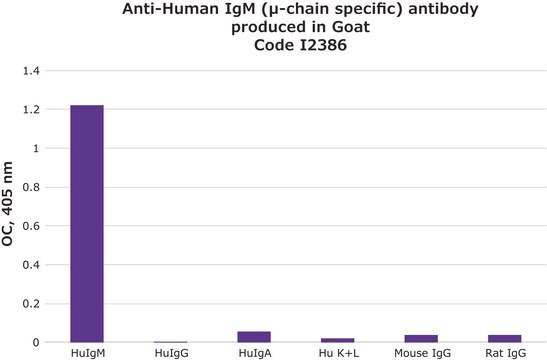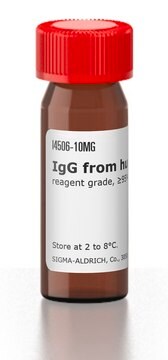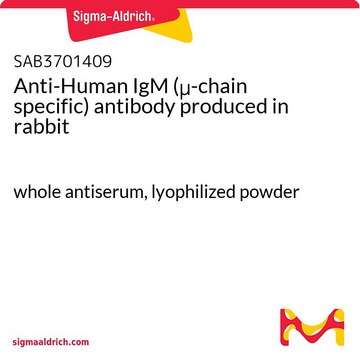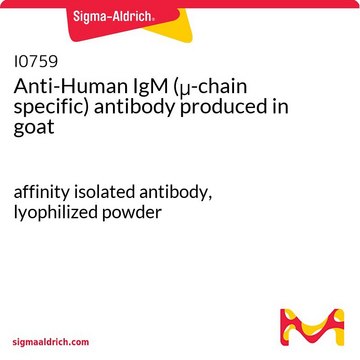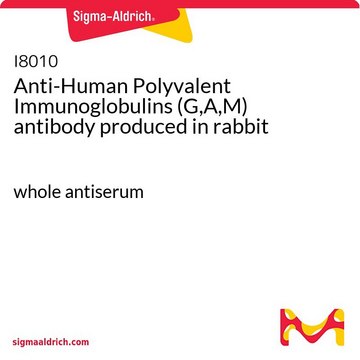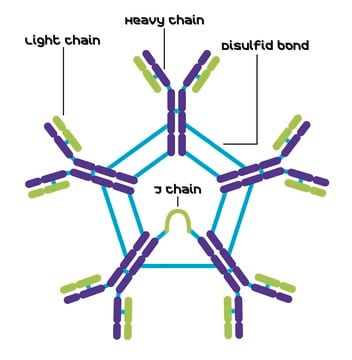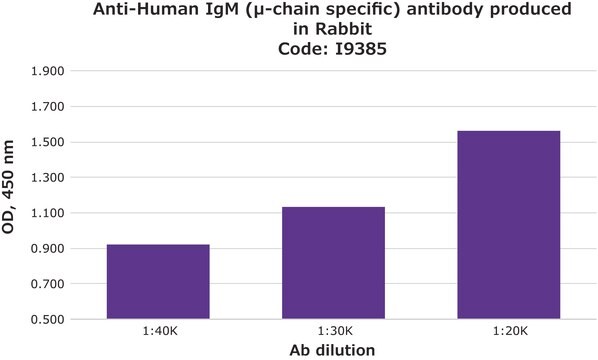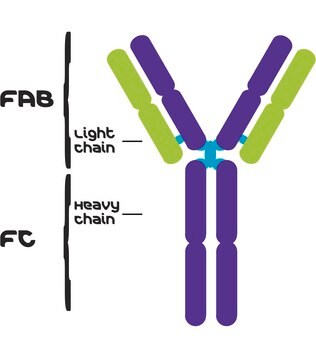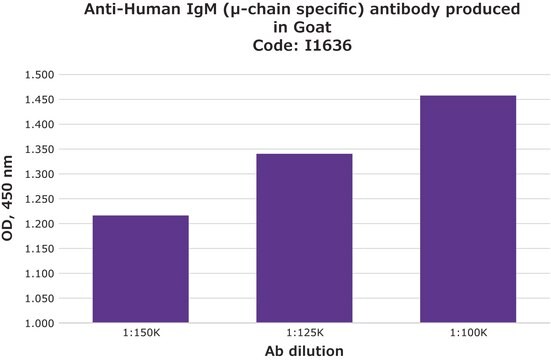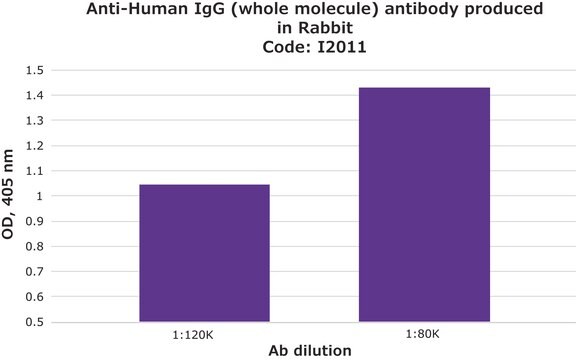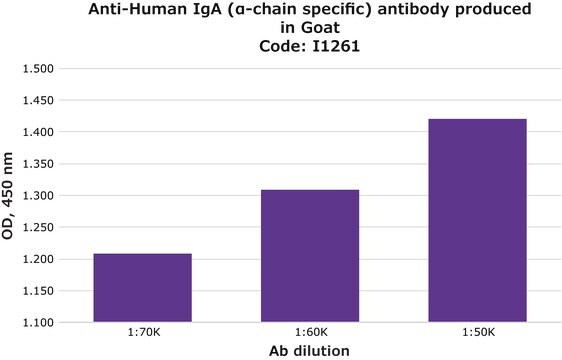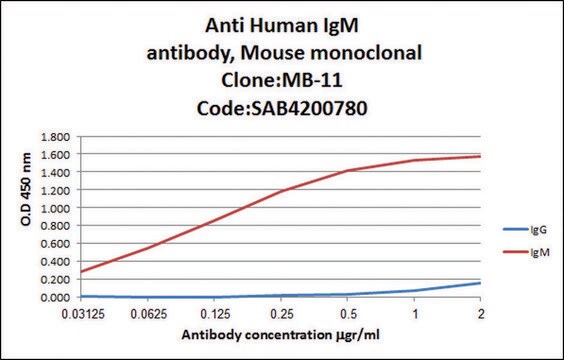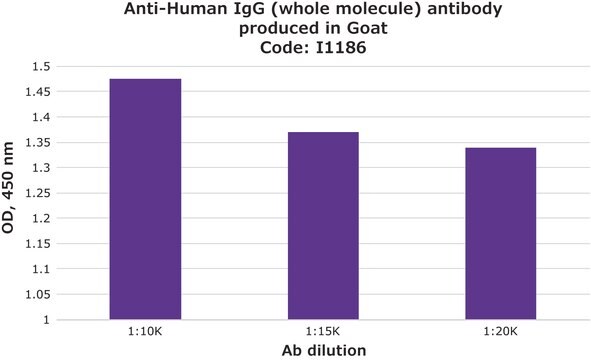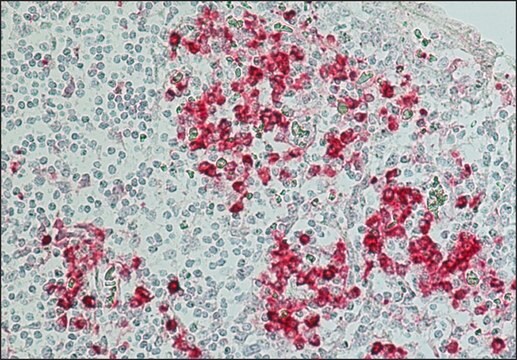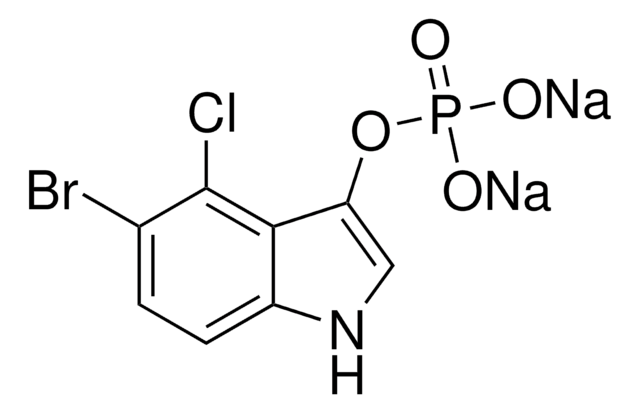Alle Fotos(1)
Wichtige Dokumente
I0140
Anti-Human IgM (μ-chain specific) antibody produced in rabbit
IgG fraction of antiserum, buffered aqueous solution
Anmeldenzur Ansicht organisationsspezifischer und vertraglich vereinbarter Preise
Alle Fotos(1)
About This Item
Empfohlene Produkte
Biologische Quelle
rabbit
Konjugat
unconjugated
Antikörperform
IgG fraction of antiserum
Antikörper-Produkttyp
secondary antibodies
Klon
polyclonal
Form
buffered aqueous solution
Methode(n)
indirect ELISA: 1:100,000
Versandbedingung
dry ice
Lagertemp.
−20°C
Posttranslationale Modifikation Target
unmodified
Suchen Sie nach ähnlichen Produkten? Aufrufen Leitfaden zum Produktvergleich
Allgemeine Beschreibung
IgM is a class of antibodies containing a pentamer of five IgG equivalents with 10 Fab fragments, joined by a single cross-linking peptide (J-chain). It constitutes 15% of the normal adult immunoglobulins.
Spezifität
The antibody preparation is specific for human IgM when tested against purified human IgA, IgG, IgM, Bence Jones kappa, and lambda myeloma proteins.
Anwendung
Anti-Human IgM (μ-chain specific) antibody produced in rabbit was used as secondary antibody in immunoblotting and indirect ELISA.
Biochem./physiol. Wirkung
IgM antibodies are present as pentamers in the serum and are produced in response to antigens.
Immunoglobulin M (IgM) antibodies appear early in the course of infections. IgM is an initial immunoglobulin produced in the developing fetus as a result of the immune response during the second trimester of pregnancy. It is then substituted by IgG. Therefore, the diagnosis of specific antibodies of the IgM class is useful in detecting chronic infections. IgM is essential for the fetal and neonatal host defense system. IgM cannot cross the placenta. Hence, the presence of IgM might indicate an intrauterine viral infection. IgM antibodies are responsible for the agglutination of red blood cells in mismatched blood transfusions. The level of IgM may vary with the status of disease or infection.
Physikalische Form
Solution in 0.01 M phosphate buffered saline, pH 7.4, containing 15 mM sodium azide as preservative
Lagerung und Haltbarkeit
For continuous use, store at 2-8 °C for up to one month. For extended storage, the solution may be frozen in working aliquots at –20 °C. Repeated freezing and thawing, or storage in "frost-free" freezers, is not recommended. If slight turbidity occurs upon prolonged storage, clarify the solution by centrifugation before use.
Haftungsausschluss
Unless otherwise stated in our catalog or other company documentation accompanying the product(s), our products are intended for research use only and are not to be used for any other purpose, which includes but is not limited to, unauthorized commercial uses, in vitro diagnostic uses, ex vivo or in vivo therapeutic uses or any type of consumption or application to humans or animals.
Sie haben nicht das passende Produkt gefunden?
Probieren Sie unser Produkt-Auswahlhilfe. aus.
Lagerklassenschlüssel
10 - Combustible liquids
WGK
nwg
Flammpunkt (°F)
Not applicable
Flammpunkt (°C)
Not applicable
Hier finden Sie alle aktuellen Versionen:
Besitzen Sie dieses Produkt bereits?
In der Dokumentenbibliothek finden Sie die Dokumentation zu den Produkten, die Sie kürzlich erworben haben.
Kunden haben sich ebenfalls angesehen
J Raper et al.
Infection and immunity, 67(4), 1910-1916 (1999-03-20)
Natural resistance of humans to the cattle pathogen Trypanosoma brucei brucei has been attributed to the presence in human serum of nonimmune factors that lyse the parasite. Normal human serum contains two trypanosome lytic factors (TLFs). TLF1 is a 500-kDa
E J Wiersma et al.
Journal of immunology (Baltimore, Md. : 1950), 160(12), 5979-5989 (1998-06-24)
Previous studies have discerned two forms of polymeric mouse IgM: moderately cytolytic (complement-activating) pentamer, which contains J chain, and highly cytolytic hexamer, which lacks J chain. To investigate the relationships among polymeric structure, J chain content, and cytolytic activity, we
Unser Team von Wissenschaftlern verfügt über Erfahrung in allen Forschungsbereichen einschließlich Life Science, Materialwissenschaften, chemischer Synthese, Chromatographie, Analytik und vielen mehr..
Setzen Sie sich mit dem technischen Dienst in Verbindung.